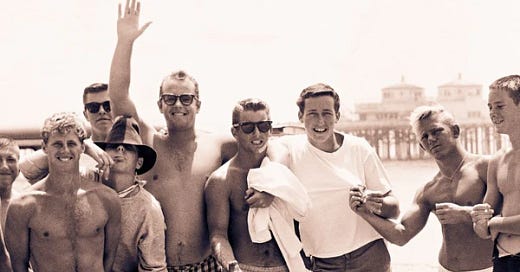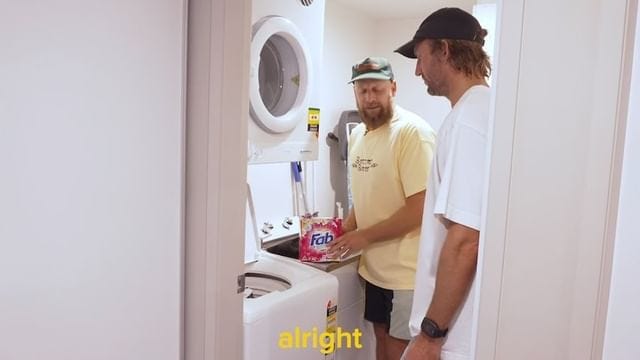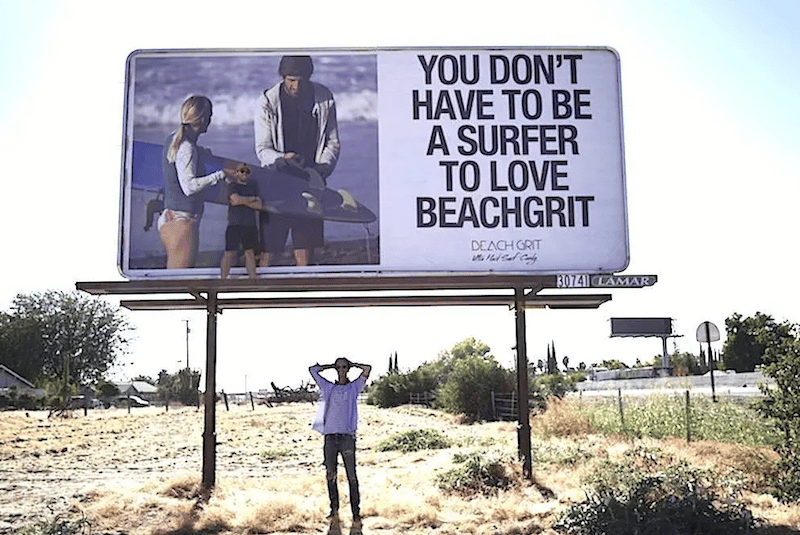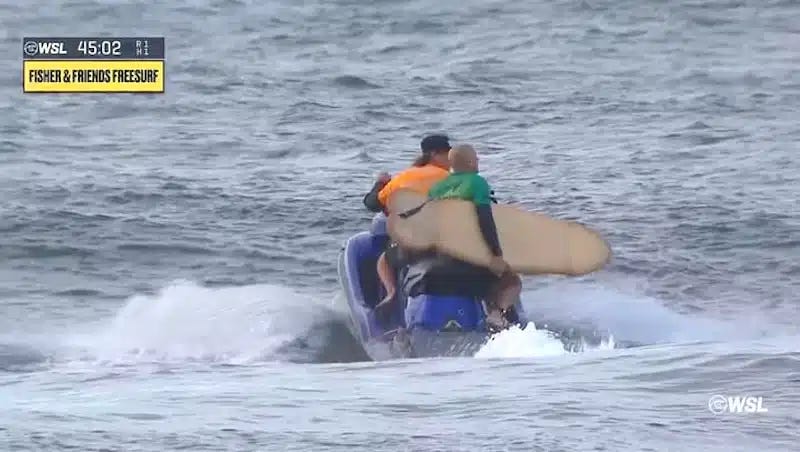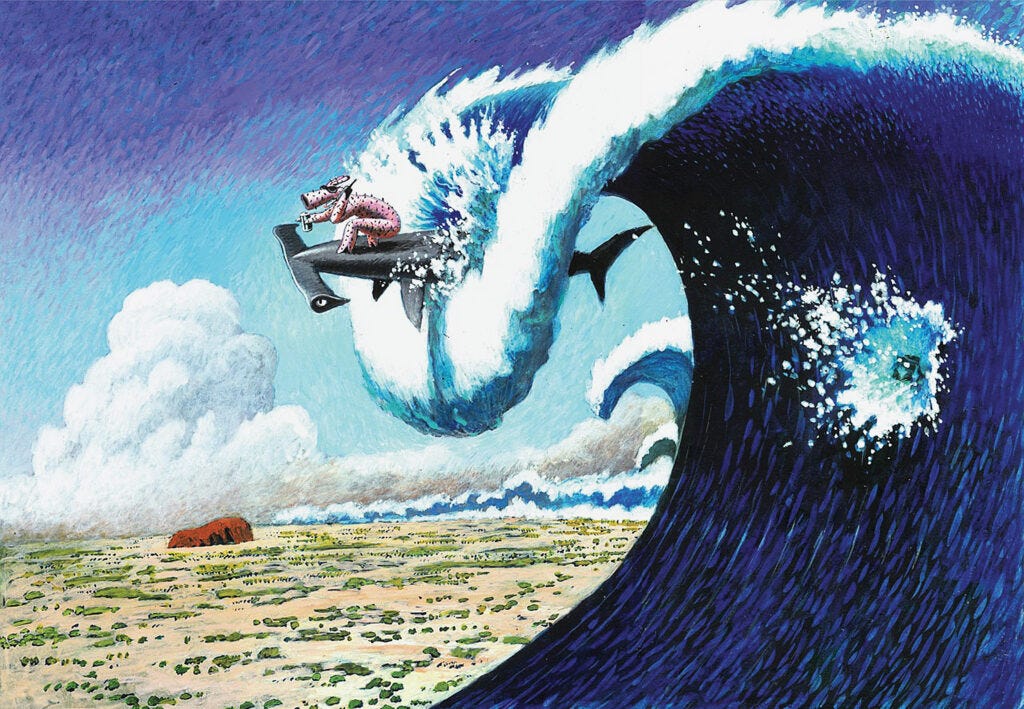Former QS surfer Luke Cederman, aka @raglansurfreport is the Funniest Cunt in Surfing™. His latest skit with Owen Wright even made me chuckle. Wright also puts in one of the better surfer actor efforts on record.
Mind you its not the highest of bars. A while ago I wrote about the fraught intersection of surfing and comedy for a print article in Tracks. I reached out to Luke for his take on it, as well eminent surf historians Matt Warshaw and Phil Jarratt. So I thought update the piece and put it out on the intranet. It’s bordering on a long read, and might just prove the theory that writing about surfing isn’t funny. Either way, I enjoyed going down the surf comedy rabbit hole. I Hope you do too.
“I was trying to be a pro surfer when I was young, and that was always very serious,” Kiwi surfer Luke Cederman told me. “Everyone was trying to look cool and be cool and no one ever let their guard down. And so I did the same. But it got the point that I was like; ‘Fuck this shit.’ Why all the testosterone and all the grumpiness?”
Cederman, responded with his Raglan Surf Report, a series of skits and videos that that take the piss out of surfing and surfers. It’s currently that very rare bird in surfing; it’s actually funny.
It had me thinking about surfing’s relationship with comedy; an often fraught and checkered dance, more drunk uncle at a wedding than Fred Astaire (one for the kids!) It led me to write this potted history of comedy and surfing, with the aim of not making it as funny as a turd in the lineup. Fark, this already needs work.
Personally I came to the investigation with the central tenet that the highpoint of surfing comedy was Bruce Brown’s Endless Summer. That was released in 1964, and I feared surfing’s relationship with comedy has been rocky, bordering on severely dysfunctional, ever since.
“Brown masterfully split the difference between his core surfing audience and a hoped-for mainstream audience,” Matt Warshaw said. “His definitively casual Southern California voice is in fact the star of the film. It was casual, and easy. Sure, it was corny, but you can hear him grinning.”
60 odd years on, the lines have dated, sure, but they still bring a smile to the dial. In the Australian section, Brown drawls. “When the girls get wiped out they have some trouble losing parts of these suits. The darn things are so little they roll up in a ball and go down a clam hole or something and they never find them again. The lifeguards down there carry spare bathing suits. They carry 15 in a Band-Aid box.”
Warshaw’s theory is that the 1960s, especially in America, surfers and surf culture were led by humour. The Malibu of the late 1950s and early 60s was a raucous, pivotal time, where laughs came first, followed by surfing. And at the head of that vanguard was a surfer by the name of Terry “Tubesteak” Tracey, who lived in a beach hut at Mali the beach in the late 1950s.
Surf Journalist Craig Stecyk recalled that Tubesteak "held court with humour and ruled with a velvet-shrouded iron hand.” According to Warshaw surf lore holds that Mickey Dora owned the waves at Malibu, while the round-bellied Tracy owned the beach; their composite Malibu style, in turn, was exported up and down the California coast and across the surfing world.
As an example, Warshaw has written how Tubesteak once did an imitation of Father Junipero Serra—the eighteenth-century Spaniard who founded Franciscan friars’ retreat next to Malibu Creek. On one sunny day Tracy dressed up in a burlap sack and rode slowly from the lagoon to First Point on an ancient swayback donkey. After distributing wine and bread to the beach crowd and giving a short blessing, Tracy then retreated back to the hills.
“For a just two or three summers at Malibu, Tubesteak was almost performance art, but based around on fucking around and being funny,” said Warshaw. “Unlike Dora though, who was funny, but mean, Tubesteak was inclusive. Everyone was in on the joke.”
The performance art element of surfing and comedy has remained a running thread throughout surfing. Take Junkyard Johnny at Jakes Point for example, whose style Tracks writer Kirk Owers described as “one-part surfer to three-parts Cirque Du Soleil. He’ll often ride through the barrel on one leg and emerge lying on his back with his feet kicking at the sky like a dying cockroach. And all just to amuse the tourists.”
BeachGrit, the website whose snarky, nihilistic humour led by Chas Smith and Derek Reilly might be classed more Dora than Tubesteak, is also a worth mention in the art-for-laughs category. The giant billboard they posted outside of Kelly’s Surf Ranch at Lemoore back in 2018, featuring a photograph of the then World Surf League’s Chief-Marketing-Officer Beth Greve, enjoying a day at the beach with her surfboard fins inserted backwards, and the tagline.“You don’t have to be a surfer to love BeachGrit,” was funny, for all the wrong, and right, reasons.
Matt Wilkinson too we can say has often positioned himself in the small Venn diagram where surfing, comedy, and performance art intersect. After all this is a man who rollerbladed into his first ever CT at Snapper, still sporting the perm he’d had done for the ASP Banquet the week before.
This year he released a country and western single titled Fucken Big Horse under the name Uncle Willy. The opening lines go “I’m a cowboy with the darkest soul and a fucken big horse, yeah I’m outta control.” The video featured him wake surfing behind a horse. A big fucken one, obviously. I mean as a post CT career it sure beats being a real estate agent, coach or surf school owner, the three options available.
It’s hard to say what exactly, or who, The Former World No.1 was channeling. Was it Joe Exotic, or Paul Fisher. You might remember Fisher’s forays into surf comedy in the early 2010s through his Followthefish blog. It’s probably best illustrated by his post heat interviewers where he used a giant dildo shaped microphone.
Fisher morphed his outlandish persona, pro surfer connections, love of nudity and puerile sense of humour into a successful party guy persona. He then parlayed that persona into a career as a grammy nominated international DJ. The mix sees him with over a million instagram followers, Las Vegas residencies, single release with J-Lo and more money than all the pro surfers in the history of the sport have ever accumulated. He boxed it off this year bringing back after surfing the penis board at Snapper and then DJing to 30,000 fans on the beach.
However if all these attempts can be traced back to Tubesteak’s efforts in the 1950s, and Endless Summer’s pithy tone cracking the mainstream in the late 1960s, surfing, suddenly, lost its sense of humour. “Surfing got so burdened with non humour, not so long after Endless Summer,” says Warshaw. “From 1969 it was presented as this heavy, spiritual pursuit. It was a comedy dead zone as it became laden down with its own bullshit.”
The Aussie mag Tracks played its own duplicitous role; first in doubling down on the spiritual bullshit, and then being a guiding light in bringing back the lols. First published in October 1970 Tracks covered not only surfing and the counterculture but the environment, pollution, drugs and politics. In those early years it often had pages on pages of meditation tips, but little laughs.
That all changed when Phil Jarratt got involved. Jarratt was a surfer, and trained journalist, from Wollongong. He’d started writing for Tracks in the early 1970s, before becoming Deputy Editor, and then Editor from 1975 to 1978.
“In 1975 Tracks had two things going for it; I could turn out humorous pieces on a regular basis, and we had Tony Edwards doing Captain Goodvibes,” Jarratt told Tracks.
Goodvibes, the Pig of Steel, has a solid claim to be not just the funniest pig in surfing at the time, but probably the funniest thing to ever happen to surfing, ever. Goodvibes is the most revered cartoon in surf culture and Tracks’ spirit animal. In the space of five or six years Tracks went from pages dedicated to mung bean recipe to the Captain’s recipe for Roast Bloke which went as follows. “Take one farm fresh hippy or commo student, wash thoroughly in bath after fumigating, pluck excess hair off and stuff with rotting compost. Cook in a hot oven for two months and serve with sloth hearts and armourdillo droppings." Goodvibes has regulary featured in Tracks (below one from 2023) ever since, with the odd decade-long fallow periods.
During his Editorship Jarratt also invented an alter ego called Clyde Strange, an ultra yobbo character that added further comedic chops to the pages of Tracks. It would also be the prototype be of a number of Editor’s characters of Tracks throughout the years. Juan Kempes and Daryl Davenport were two popular ones. 30 years after Clyde Strange, I would plagiarise Phil’s character for my own; Rod Cunthorpe.
Rod’s column would run for a decade from 2004, a miracle given the content was primarily centered around the act of fingering… cousins As an example, Rod’s 2013 New Years resolutions included, “Have Parko add a tattoo of my name (in fancy Chinese calligraphy) next to that of his three children, laugh at something Kelly Slater says, sell my two Billabong shares for more than the price of two 1985 Icy Poles, interview Alana Blanchard’s anus, expose Rasta’s cattle and whale farming operations, vote for Tony Abbott, fight Kala Alexander using Richie Vaculik as a club and offset my carbon credits by burning tyres.” Rod is now riding again here on the Bugle.
It was supposed to be funny, and satirical, the pillars that Jarratt had introduced. “By 1978 when I left, the idea that Tracks was irreverent and funny had really kicked in, and I’ll mostly claim that,” said Jarratt. It was the tone that inspired Tracks contributors over the years. From DC Green and his Lash Clone comic in the 1990s, to the work of artist Johann Leak’s in the 2000s, the aim, not always realised, was to be funny.
In the intervening years though it’s hard to say whether that irreverant humour in has been a defining, or declining, aspect of surf culture. After reading this, you may be inclined to the former. Surf movies in particular have often been guilty of attempting funny, and failing miserably.
“If you could colour chart most surf movies, with blue being the surf action, and red being the comedy bits, it would be eight minutes blue, one minute red,” says Warshaw. “That was the surf movie template - it followed on the Endless Summer - some of were funny, and most were not.”
For me Taylor Steele was one of the great offenders in this regard. For all the incredible surfing action of his, for want of a better word, cannon, the acting skits in between were, at best, amusing adjacent, but usually, as the kids say, ‘totes cringe.”
As ever there are exception to the rules; usually any film involving Adam “Vaughan” Blakey, has featured large dollops of humour often missing from other surf flicks From Doped Youth (featuring a comedic turns from Parko and Fanning as Greasy and Lemmy) to Postcards From Morgs, Blakey has repeatedly managed to distil the best of the surf humour that can be found at any beach car park, or coastal beer garden, in Australia. His filth-laded The Greatest Surf Movie In The Universe took all that, added animation, poured aviation fuel all over it, and then lit the fucker up.
In writing, and surf magazines in particular, only a few scribes have been able to elevate themselves to what can be considered the art of comedy. Lewis Samuels, first with his short-lived PostSurf website (“he reminds me of Charles Dickens, if Dickens were a Sydney metrosexual comfortable in the company of a young Oscar Wilde,”) and Surfline’s Power Rankings were groundbreaking. A potent mix of half truth, full truth, satire, real reporting and a blatant disregard for the norms of surf journalism whose first rule was always to protect the athletes, and by extension, the brands. Mainly though, it made you laugh.
Jock Serong’s Short History series in Surfing World too was a rare treat, where every word was carefully placed for maximum comic effect. Be it on thongs (“There are currently thought to be six million thongs floating around the world’s oceans. The only comforting thing about such a hideous statistic is that it’s an even number, so theoretically they can all one day be paired again) or sun lotion (Jodie Foster made her acting debut as a three-year-old in a Coppertone ad, the tagline of which read: “Beautiful tan today, young-looking skin tomorrow.” It’s an oxymoron and a blatant lie, but it does have a little more joie de vivre than “Tanning is skin cells in trauma”.) No wonder that Serong has gone on to be recognised as one of Australia’s great contemporary novelists. Surfing’s loss was literary’s gain. A sentence that has never been written before.
However it’s probably the internet and social media streams that have advanced the ratio of misses to hits. It’s probably why sites like @Kookslams and @lennox_rocks are so popular. Without crafted, curated comedy, surfers are forced to laugh at learners getting pitched head first into the shorey, or watching as a mal rider mistimes a rock jump and gets lacerated over the barnacles.
Those rare birds that create humour therefore are all the more prized. Be it Instagram accounts like @surfcore2001 and @thegreenroomtimes, and the Raglan Surf Report.
“I mean if you just take the piss out of standup paddle board and foiling, you’ll get laughs,” Cederman says modestly. “I mean it’s low hanging fruit, but those subcultures tend to take themselves way more seriously. That why it’s all the more sweeter when it works.”
When asked what he finds as the most amusing thing in surf culture right now he didn’t hesitate. “The WSL’s The Ultimate Surfer is hilarious. Probably the funniest thing to ever happen to surfing.” In fact the WSL’s role, and I’ll include myself in that as a long time contributor, in pissing all over the fire of surfing comedy must be highlighted.
After all this is an organisation that produced “Get Sent with Chad and JT” which Tracks’ Ben Bugden called surfing’s “Peak Cringe” moment. A big call if you’ve ever seen an eight-schoonered, cocaine-addled World Champ deliver a speech at a charity award night. That the sport’s governing body provides about as much laughs as the recently divorced, ex-boxer, 15 stone mini-man rider that only surfs your local in summer, isn’t helping.
In many ways Get Sent was trying to mine the laughs that Sterling Spencer dug from surfing’s coal face for a few golden years at the start of the last decade and which he’s recently returned too with @pinchmysalt. At that time Sterling Spencer wasn’t just the funniest man in surfing, he was the only funny man in surfing. His Instagram skits and youtube posts on pinchmysalt.tv used his uncanny impersonations, overdubs and oddball sense of humour to create real laugh out loud moments, a rarity in the surfing genre.
In the weird and wonderfully ambitious move Gold, His skit with American comedy legend Bob Saget, might just be the finest example of the genre. Saget plays a legendary shaper making boards for Sterling, the aspiring pro. Saget however increasingly becomes fixated with Spencer’s mum, who it becomes apparent he had once had a relationship with. It gets to the point where Sterling believes that he may be the shaper’s son. It ends with Saget throwing cold water on that theory with the line, “Oh no son, that’s impossible, not the way me and your mum did it.”
With its undertones of smut, with its poke at the surfer-shaper relationship, and with Sterling being the butt, rather literally, of his own joke, it’s the type of humour that surf culture needs, but all too rarely receives.
“If surfing loses its humour we are fucked,” says Jarratt. “I mean the Waikiki beach boys loved nothing more to drink and a joke. They’d sit around and play the ukuleles and laugh all night, and try and get laid by the girls they’d taken surfing. It was funny and a bit dirty, from the very beginning. We have to remember we are renegades and rebels, and with that comes the ability to make fun of each other, and the mainstream who don’t get it.”
Or as Captain Goodvibes put it; “Surf’s short, Death’s Long, So’s my dick, Pass the bong.”

